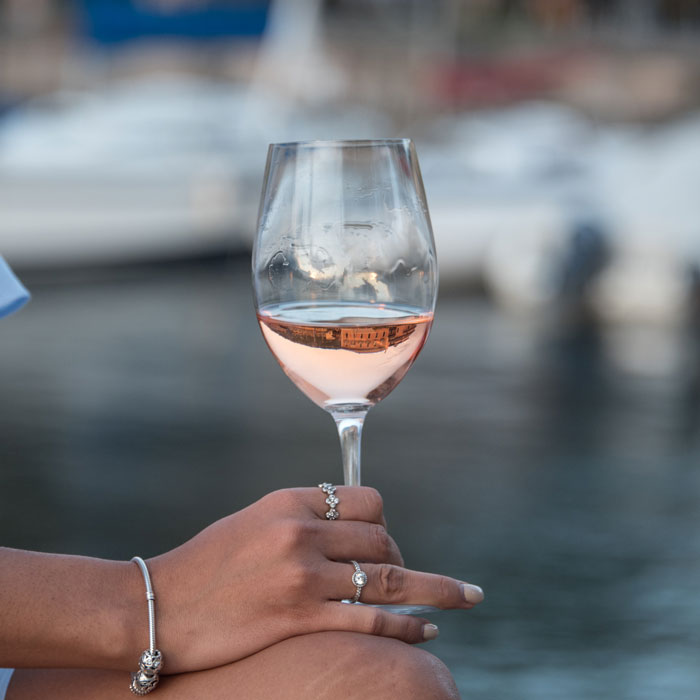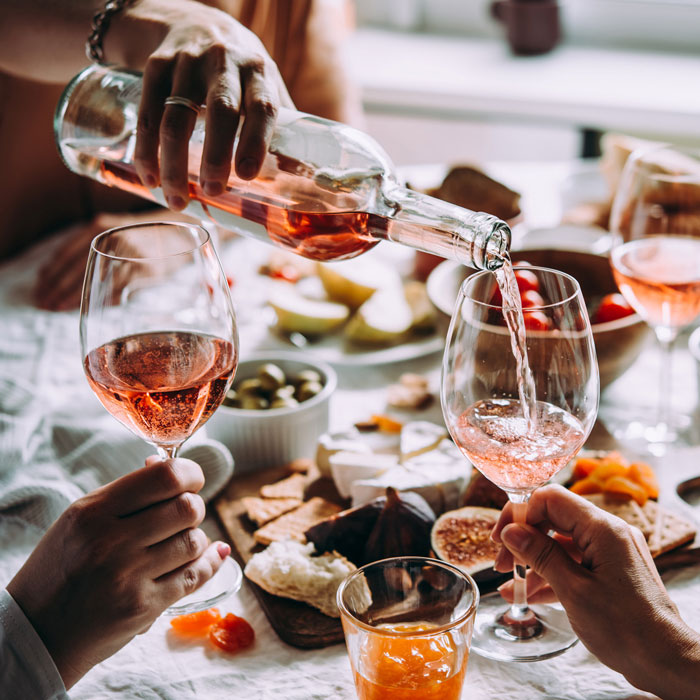
The world drinks pink
Uncomplicated and light: rosé wines are the international trend.
For a long time, rosé wines were not taken seriously by wine connoisseurs. They were considered second category wines, with a residual sweetness unpleasant for less demanding palates. But its image has changed: Global consumption of rosé wines is increasing rapidly, as is its quality and prices.
«Bebe rosa» is the motto of the German Wine Institute (DWI) for 2022. In both the ProWein and the upcoming events, this year the focus is on rosé wines. In doing so, DWI is paying tribute to a global trend that does not seem to subside. Recently, DWI reported that sales of German rosé wines abroad had developed very positively. There is a clear trend towards higher quality rosés, which are not considered primarily as a thirst quenching product, but as a wine in its own right. But not only German rosés are on the rise: the Prosecco Rosé, the Chiaretto di Bardolino, the wines of the Côtes de Provence… All of them are experiencing increasing demand, especially among younger female generations. Rosé wine is in fashion.

Isn’t the rosé for wine connoisseurs?
Die-hard lovers of red wine accuse rosé wines of lacking all that can be extracted from the grape skin: color, aromas, structure, character. In addition, rosé is a technical wine: the terroir characterizes it much less than its production method. It is a product without real identity, interchangeable, its origin is secondary.
But sales figures speak for themselves: according to the DWI, pink now accounts for 13% of total sales in Germany, and the trend is upwards. Because light, delicate, fruity, uncomplicated, this is how wine should taste for many people today. There’s hardly a wine merchant who’s not running a rosé campaign. As summer wine, as terrace wine, as an aperitif, as an expression of joy of life and lightness, the list of positive attributes with which rosés are advertised is long. And indeed, rosé wine sales increase exponentially with temperatures. The closer the holidays come, the more rosé they are drunk. As if a glass of pink were a small mental excursion to warmer climates, to Provence or Lake Garda.
Tradition versus fashion
The most famous growing areas for rosé wines are undoubtedly in the south of France. Above all, the name Côtes de Provence, 20,000 hectares, clearly sets the tone as the largest producer of rosé in the world. For many, the wines produced here represent the ideal type of rosé with which all other rosé wines must be measured. More than 90% of the denomination is dedicated to the production of rosés.
Among the most expensive rosé wines in the world are the Clos du Temple by oenologist Gérard Bertrand de Narbonne, in Languedoc, for about 200 euros, the Étoile de Domaines Ott for about 130 euros or the Garrus de Château d’Esclans, also from Provence, which costs about 100 euros. Miraval wines, whose best rosé, Muse de Miraval, now costs more than 250 euros per bottle, are equally popular.
But the name of Tavel, in the south of the Rhone, is also known for its high quality rosés. A few weeks ago it was announced that the renowned Domaine E. Guigal (Côte-Rôtie) had acquired the Château d’Aqueria, in the Tavel region, with 68 hectares of vineyards. According to CEO Philippe Guigal, the AOC Tavel is the excellence of rosé. It plans to reposition the entire Tavel name and communicate it differently to give it the status it deserves.
To raise the status of rosé wines internationally, in March 2021 the «Association Internationale des Rosés de Terroirs» (AIRT) was founded in Tavel. The aim of the association is to facilitate the access to high quality rosé wines to merchants and wine lovers and organize tastings at home and abroad.

Once red, now pink
To catch up with their French counterparts, many Italian winegrowers have also followed suit and are now increasingly focusing on rosé. Only a few appellations of origin have this tradition in Italy; one of them is the wine region of Bardolino, on Lake Garda. Here, rosé has always been produced together with red wine, but since the «rosé revolution» initiated by the consortium in 2014, the Chiaretto di Bardolino has not ceased to gain importance. It now accounts for 42% of total production. Angelo Peretti, director of the Chiaretto and Bardolino protection consortium, plans to increase Chiaretto’s production by 60%, corresponding to some 15 million bottles. The winemakers are right; in the first two months of 2022 alone, sales increased by 26.7% over the previous year.
Also noteworthy is the evolution of the Prosecco Rosé, introduced in 2020. Of the 627.5 million bottles of Prosecco DOC produced, 71.5 million bottles had already been filled with Prosecco Rosé by 2021. Demand for this new version of the Prosecco far exceeds supply.
Whether in Piedmont, Tuscany or Sicily, even the winegrowers of the classic regions growing red wines full of character now offer rosés made with Nebbiolo, Sangiovese and Nerello Mascalese because they want to be up to date.

More character, more typicality
So a lot of things are happening in terms of the quality of the rosé. The awareness of the best winegrowers is changing, standards are rising. Nowadays, winemakers take much more care of winemaking, playing with the ageing times in barrels and maceration to extract more color and structure. Because the demand for high quality rosé wines, which can also be good food companions, continues to increase.
A manufacturer of rosé wine convinced is the Austrian Pia Strehn, from Burgenland. According to Strehn, it is at least as difficult to make an excellent rosé as a good red or white wine. A good pink has to be independent and expressive. To achieve this, winegrowers have to find the best terroirs and the right grape varieties.
More and more wine growers around the world are opting for rosé: this will change a lot in the coming years. The number of wines full of character from a wide variety of appellations of origin continues to grow. Rosé, once only offered as a wine without economic pretensions, has a new future.
SOURCE: REVISTA.WEIN.PLUS
